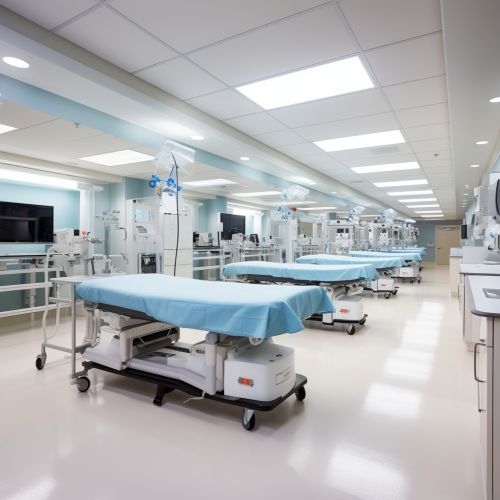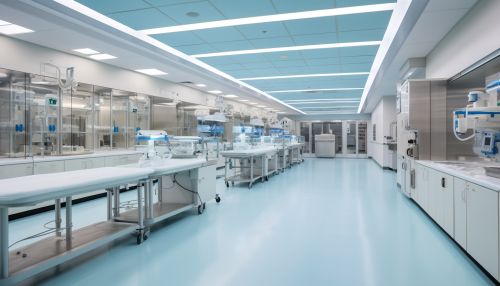Catheterization laboratory
Introduction
A catheterization lab, often referred to as a cath lab, is a specialized room in a hospital or health care facility. It is equipped with diagnostic imaging equipment used to visualize the arteries and chambers of the heart, and treat any stenosis or abnormal conditions found.


History
The history of the catheterization laboratory is closely tied to the development of cardiac catheterization, a procedure that was first performed in 1929 by German physician Werner Forssmann. He inserted a catheter into a vein in his arm and guided it into his heart, an act for which he was awarded the Nobel Prize in Physiology or Medicine in 1956.
Equipment
A catheterization lab is equipped with a variety of specialized equipment, including:
- A fluoroscope, which provides real-time X-ray imaging of the patient's cardiovascular system.
- A patient table, which can be adjusted to allow for optimal imaging.
- An injector, which delivers contrast media into the patient's bloodstream to enhance the visibility of the cardiovascular system.
- A hemodynamic monitoring system, which tracks the patient's vital signs during the procedure.
- An image processing system, which captures and stores the images produced by the fluoroscope.
Procedures
Several types of procedures can be performed in a catheterization lab, including:
- Coronary angiography, a procedure that uses contrast dye and X-ray imaging to examine the arteries of the heart.
- Percutaneous coronary intervention (PCI), a procedure used to treat coronary artery disease.
- Balloon angioplasty, a procedure in which a small balloon is inflated within a blocked artery to widen it and improve blood flow.
- Stent placement, a procedure in which a small mesh tube is placed in an artery to prevent it from narrowing again after angioplasty.
- Electrophysiology studies, which test the electrical activity of the heart to find where an arrhythmia (abnormal heartbeat) is coming from.
Risks and Complications
While catheterization lab procedures are generally safe, they do carry some risks and potential complications. These can include:
- Bleeding or bruising at the catheter insertion site.
- Damage to the blood vessels.
- Arrhythmias or irregular heart rhythms.
- Heart attacks or strokes.
- Allergic reactions to the contrast dye.
- Kidney damage, particularly in patients with pre-existing kidney conditions.
Future Developments
The field of catheterization lab technology is continually evolving, with ongoing research and development aimed at improving patient outcomes and procedural efficiency. Future developments may include advances in imaging technology, the use of robotics, and the development of new, less invasive procedures.
